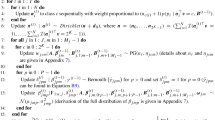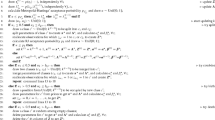Abstract
Starting from perfectly discriminating nonmonotone dichotomous items, a class of probabilistic models with or without response errors and with or without intrinsically unscalable respondents is described. All these models can be understood as simply restricted latent class analysis. Thus, the estimation and identifiability of the parameters (class sizes and item latent probabilities) as well as the chi-squared goodness-of-fit tests (Pearson and likelihood-ratio) are free of the problems. The applicability of the proposed variants of latent class models is demonstrated on real attitudinal data.
Similar content being viewed by others
References
Birnbaum, A. (1968). Some latent trait models and their use in inferring an examinee's ability. In F. M. Lord & M. R. Novick (Eds.),Statistical theories of mental test scores. Reading/MA: Addison-Wesley.
Clogg, C. C. (1977).Unrestricted and restricted maximum likelihood latent structure analysis: A manual for users (Working Paper 1977-09). University Park, PA: The Pennsylvania State University, Population Issues Research Center.
Clogg, C. C., & Sawyer, D. O. (1981). A comparison of alternative models for analyzing the scalability of response patterns. In S. Leinhardt (Ed.),Sociological methodology 1981 (pp. 240–280). San Francisco: Jossey-Bass.
Davison, M. L. (1980). A psychological scaling model for testing order hypotheses.British Journal of Mathematical and Statistical Psychology, 33, 123–141.
Dayton, C. M., & Macready, G. B. (1976). A probabilistic model for validation of behavioral hierarchies.Psychometrika, 41, 189–204.
Dayton, C. M., & Macready, G. B. (1980). A scaling model with response errors and intrinsically unscalable respondents.Psychometrika, 45, 343–356.
Dempster, A. P., Laird, N. M., & Rubin, D. B. (1977). Maximum likelihood from incomplete data via the EM algorithm.Journal of the Royal Statistical Society, Series B, 39, 1–38.
Formann, A. K. (1984).Die Latent-Class-Analyse. Einführung in Theorie und Anwendung. [Latent class analysis. An introduction into theory and applications]. Weinheim: Beltz.
Formann, A. K. (1985). Constrained latent class models: Theory and applications.British Journal of Mathematical and Statistical Psychology, 38, 87–111.
Goodman, L. A. (1974). Exploratory latent structure analysis using both identifiable and unidentifiable models.Biometrika, 61, 215–231.
Goodman, L. A. (1975). A new model for scaling response patterns: An application of the quasi-independence concept.Journal of the American Statistical Association, 70, 755–768.
Guttman, L. (1950). The basis for scalogram analysis. In S. A. Stouffer, L. Guttman, E. A. Suchman, P. F. Lazarsfeld, S. A. Star & J. A. Clausen (Eds.),Studies in social psychology in World War II, Vol. IV:Measurement and prediction. Princeton: Princeton University Press.
Jansen, P. G. W. (1983).Rasch analysis of attitudinal data. (Proefschrift) Nijmegen: 's-Gravenhage.
Lazarsfeld, P. F., & Henry, N. W. (1968).Latent structure analysis. Boston: Houghton Mifflin.
Macready, G. B., & Dayton, C. M. (1977). The use of probabilistic models in the assessment of mastery.Journal of Educational Statistics, 2, 99–120.
McHugh, R. B. (1956). Efficient estimation and local identifiability in latent class analysis.Psychometrika, 21, 331–347.
Proctor, C. H. (1970). A probabilistic formulation and statistical analysis of Guttman scaling.Psychometrika, 35, 73–78.
Rasch, G. (1960).Probabilistic models for some intelligence and attainment tests. Copenhagen: Paedagogiske Institut.
Rindskopf, D. (1983). A general framework for using latent class analysis to test hierarchical and nonhierarchical learning models.Psychometrika, 48, 85–97.
Sixtl, F. (1973). Probabilistic unfolding.Psychometrika, 38, 235–248.
Thurstone, L. L. (1929). Theory of attitude measurement.Psychological Review, 36, 222–241.
Torgerson, W. S. (1958).Theory and methods of scaling. New York: Wiley.
Author information
Authors and Affiliations
Additional information
This research was supported by the Kulturamt der Stadt Wien, Magistratsabteilung 7.
The author wishes to thank the editor, Ivo W. Molenaar, as well as Clifford C. Clogg and the anonymous reviewers for their valuable comments on the earlier drafts of this paper.
Rights and permissions
About this article
Cite this article
Formann, A.K. Latent class models for nonmonotone dichotomous items. Psychometrika 53, 45–62 (1988). https://doi.org/10.1007/BF02294193
Received:
Revised:
Issue Date:
DOI: https://doi.org/10.1007/BF02294193




